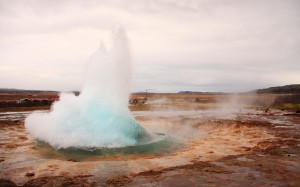Piilevistä kirjoittava Mira Tammelin on jatko-opiskelija geologian osastolla. Tämä positiivinen ja ahkera tutkija on erikoistunut paleolimnologiaan keskittyen erityisesti piileviin, tilastomenetelmiin ja järvien rehevöitymiseen. Vapaa-ajalla innokas valokuvaaja opiskelee ohjelmistotuotantoa.
The writer Mira Tammelin is a PhD student at the geology section. This positive and hardworking researcher is specialized in paleolimnology with the main focus on diatoms (the topic of this blog post), statistical methods and lake eutrophication. On her spare time, she is an enthusiastic photographer and studies software development.
Mitä piilevät ovat ja mitä ne kertovat meille?
Useimmat meistä ovat kuulleet metsiä kutsuttavan Maapallon keuhkoiksi. Metsät ovat vehreitä ja täynnä elämää, joten niitä on helppo arvostaa, mutta ne eivät ole kuitenkaan ainoat keuhkomme. Todellisuudessa piilevät tuottavat 20-40% hengittämästämme hapesta. Mutta mitä piilevät oikein ovat?
Piilevät ovat kasviplanktonia eli mikroskooppisia leviä, joilla on vahvat piistä rakentuvat soluseinät. Jokaisella piilevälajilla on soluseinässään kaunis, omaleimainen kuviointi, jota voidaan hyödyntää piilevälajien luokittelussa. Piilevälajeja on lukuisia, arviot niiden määrästä vaihtelevat kymmenistä tuhansista miljooniin. Osa lajeista on kuitenkin jo kuollut sukupuuttoon. Kooltaan piilevät vaihtelevat muutamasta mikrometristä muutamaan millimetriin saakka. Myös yksittäisen lajin koko vaihtelee, sillä piilevät kykenevät lisääntymään jakautumalla, jolloin levän koko pienenee.
Piilevien soluseinien kuvioinnit ovat kauniita ja tietylle lajille omaleimaisia, mikä tekee lajitunnistuksesta helpompaa.
Vaikka valtameret lienevät tunnetuimpia kasviplanktonin asuinpaikkoja, piilevät voivat elää missä tahansa riittävän kosteassa ympäristössä. Ne ovatkin runsaita sisämerissä, järvissä, joissa, puroissa, suistoalueilla, soilla ja jopa metsissä. Tietyt lajit pystyvät sietämään vaativiakin oloja, kuten erittäin happamia ja lämminvetisiä kuumia lähteitä. Juuri se, että tietyt lajit viihtyvät tietyissä olosuhteissa, mahdollistaa piilevien hyödyntämisen ympäristötutkimuksessa.
Tietyt piilevälajit sietävät vaativiakin oloja, kuten kuumien lähteiden ja geysirien hapanta ja kuuma vettä.
Mitä piilevät voivat siis kertoa meille? Ne voivat paljastaa vesistön ympäristöhistorian altaan muodostumisesta saakka kertomalla milloin, miksi ja kuinka paljon vesistö on muuttunut sisältäen sekä luontaiset että ihmisperäiset muutokset. Vahvojen soluseiniensä takia piilevät säilyvät kuolemansa jälkeen vesistön pohjaan kerrostuneessa sedimentissä. Sedimenttipatja muodostaa ympäristöarkiston, joka edustaa sitä vanhempaa aikaa mitä syvemmälle sedimentissä mennään. Kunkin sedimenttisyvyyden piilevälajisto siis edustaa vedenlaatua tiettynä ajankohtana menneisyydessä. Tuhansien järviemme pohjassa olevat piilevät odottavat salojensa paljastamista!
What are diatoms and what do they tell us?
Most of us have heard that forests are the lungs of the Earth. Forests are nice and green and filled with life, which makes it easy to appreciate them, but they are not our only lungs. Actually, diatoms produce 20-40% of the oxygen that we breathe. But what are diatoms?
Diatoms are phytoplankton, in other words, microscopic algae that have strong siliceous cell walls. These cell walls can be used in the classification of diatom species as each species has a unique and often beautiful pattern decorating their cell wall. There is an enormous variation within the diatom group and the estimated number of different species ranges from tens of thousands up to millions. Some of these species are already extinct, however. Diatoms range in size from a few micrometers to a few millimeters. The size of a single diatom species also varies, because they can reproduce by dividing which decreases the cell size.
Diatoms have unique and beautiful patterns on their cell walls, which makes it easier to identify different species.
Even though oceans might be the first thing that comes into mind when speaking about the living habitats of phytoplankton, diatoms can actually live anywhere where there is enough moisture. This means that they are found in seas, lakes, rivers, streams, wetlands, swamps and even in forests. Certain diatom species can also persist in very harsh conditions, for example in hot springs with extremely acidic and warm waters. In fact, this preference of certain species to live in certain environmental conditions is the reason for the usefulness of diatoms in environmental research.
Some diatom species can tolerate harsh conditions, such as the heat and acidity of hot springs and geysirs.
So, what can diatoms tell us? They can reveal the environmental history of the water body in which they live. They tell us when, why and how much a water body has changed since its formation, including the natural as well as the human-related changes. Because of their strong cell wall, diatoms are preserved after their death within the sediment on the bottom of a water body. The accumulated sediment gets older the deeper we go into it. Therefore, the diatom assemblage at each sediment depth level reflects the water quality conditions of a specific time period in the past. The diatoms at the bottom of our thousands of lakes are waiting to get their secrets uncovered!



